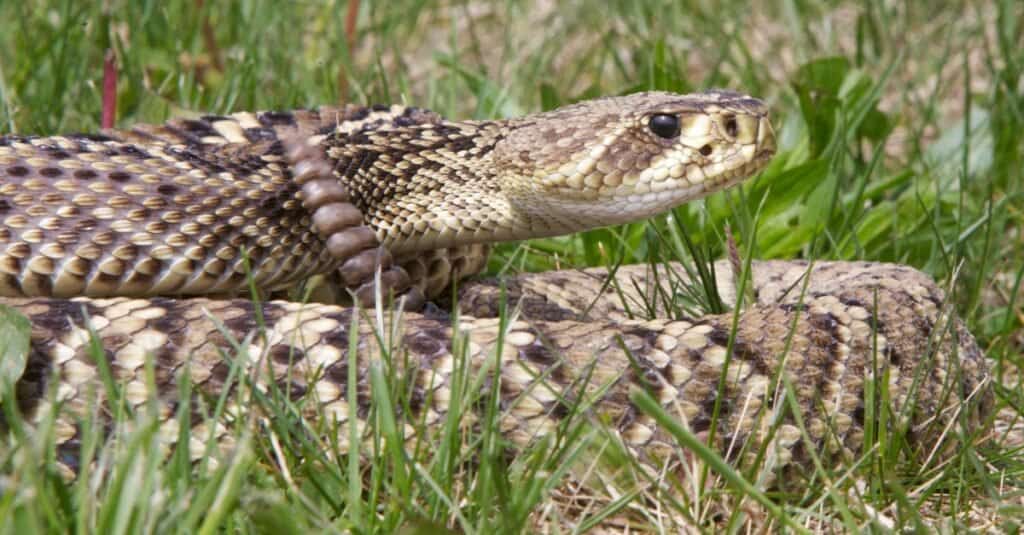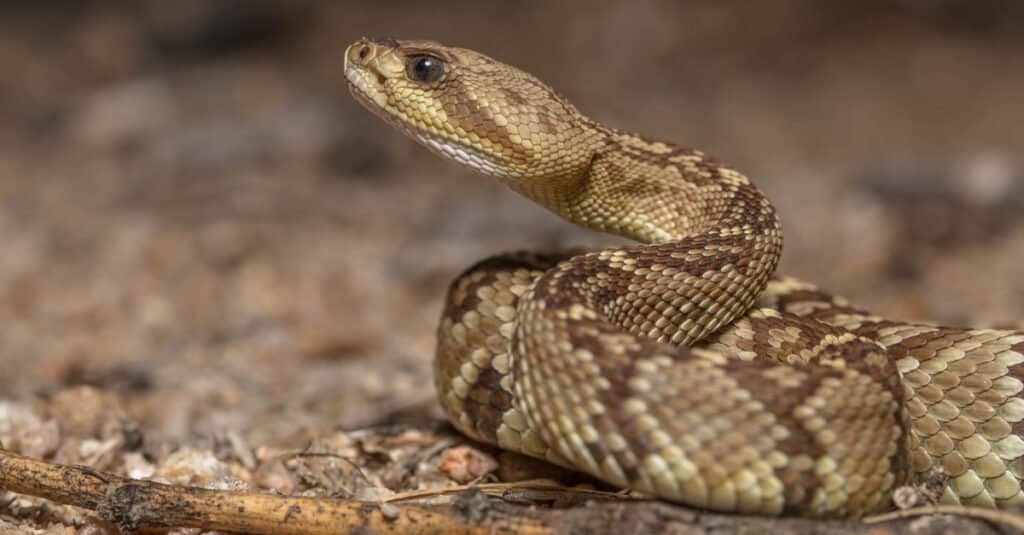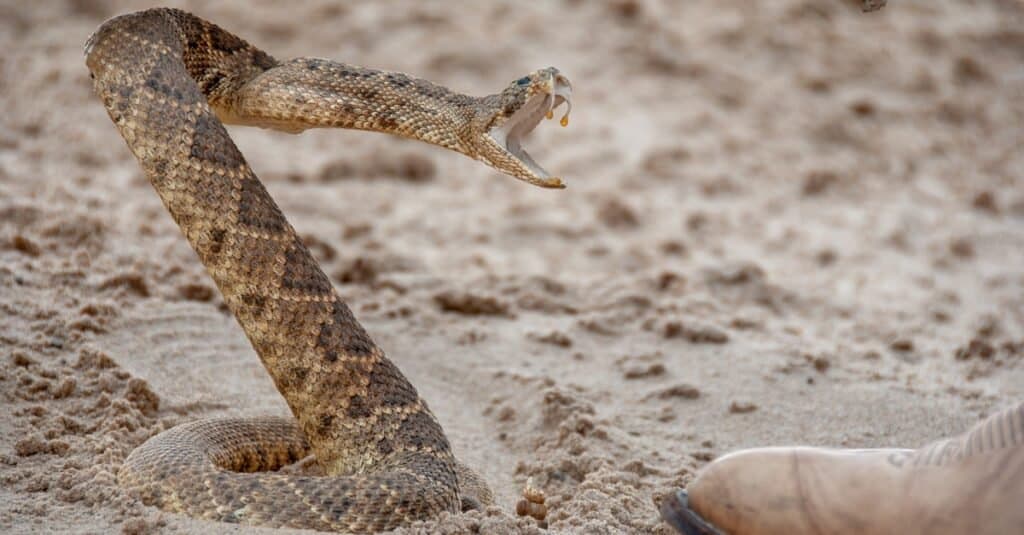Perhaps one of the most unique and iconic snake species on the planet, rattlesnakes may seem harmless when their mouths are closed, but once they unhinge their wide jaws, it is a terrifying sight indeed. Rattlesnakes have 36 species, all native to the United States and some parts of Canada and Argentina. Rattlesnakes are venomous, which makes them dangerous hunters in the wild. They mostly eat various land-dwelling animals and are rarely kept as pets. Rattlesnake is not the best idea for a pet snake as its bite can be fatal.
Rattlesnakes got their name from the distinct “rattle” by the end of their tails. These rattles are made of segments of keratin, forming a series of interlocking scales. As rattlesnakes contract their muscles at the tip of their tails, the scales create a distinct rattling sound that warns predators away. As venomous carnivores who have their own predators to escape from in the wild, we can’t help but wonder, what do rattlesnakes eat? And how do they hunt for food?
What Do Rattlesnakes Eat?

Rattlesnakes eat a diet that includes amphibians, insects, reptiles, birds, and others.
©iStock.com/NajaShots
Rattlesnakes are carnivores who eat a variety of animals in their diet. These animals include amphibians, reptiles, insects, birds, small mammals, and others. Rattlesnakes are ambush predators that often lie in hiding for days, waiting for unsuspecting prey to wander, then lash out on them using their venomous fangs.
A Complete List of Food Rattlesnakes Like to Eat:
Rattlesnakes hunt a range of animals available to them in the wild, including different kinds of amphibians, reptiles, and mammals. Rattlesnakes mostly eat a diet that includes:
- Frogs
- Toads
- Newts
- Salamanders
- Rodents
- Mice
- Rats
- Hamsters
- Moles
- Rabbits
- Squirrels
- Mongooses
- Birds
- Bird eggs
- Lizards
- Small Crocodiles
- Grasshoppers
- Crickets
- Beetles
- Termites
Amphibians
As rattlesnakes often inhabit grasslands and swamps, they prey on animals living close to water sources such as amphibians. Rattlesnakes eat salamanders, newts, frogs, toads, and other amphibians small enough to bite.
Reptiles
Other animals living near water sources of rattlesnakes are reptiles, including small crocodiles. Rattlesnakes are observed only to eat small crocodiles, so it is easy for their digestion. These pit vipers also eat a variety of lizards.
Small mammals
Rattlesnakes’ favorite food are small mammals, especially rodents. They hunt mammals by waiting for them to wander near their hiding place. Rattlesnakes eat a variety of rodent species like hamsters, rats, mice, squirrels, and mongooses.
Insects
Younger and smaller rattlesnakes mainly consume insects. These young pit vipers will eat any hoppers they can find, such as grasshoppers, cockroaches, termites, and crickets.
Rattlesnake species do not have many variations in their diet. However, there are instances when rattlesnakes might strike and eat other snake species.
What Do Baby Rattlesnakes Eat?

Baby rattlesnakes
mostly eat insects and small lizards.
©Alexander Wong/Shutterstock.com
Baby rattlesnakes mostly eat small lizards and insects. As babies, rattlesnakes possess more neurotoxins in their venom, so they can find and kill their prey more quickly. Baby rattlesnakes are more dangerous in the wild since they can be more unpredictable than adult rattlesnakes. The “rattlers” of baby rattlesnakes are not yet developed, making them stealthier predators.
How Do Rattlesnakes Hunt for Prey?
As venomous snakes, rattlesnakes do not strangle their food. Instead, they use poisonous bites that can paralyze and eventually kill their prey. Rattlesnakes are ambush predators, and they usually lie and hide for days, waiting to strike at any prey that may wander their habitat.
Like all snake species, rattlesnakes do not have chewing teeth to help them grind their food before digesting. They have fangs that are 4 to 6 inches long and through which they inject their venom into their prey. These hollow fangs can be folded parallel into the roof of their mouths when closed. Once these fangs have injected venom onto the rattlesnake’s prey, they can easily track and follow their own venom’s scent and can hunt the prey down again if ever they escape the first time. They also have pit organs that help track their prey through their heat emissions.
How Do Rattlesnakes Eat Their Food?
Like all snake species, rattlesnakes swallow their food whole, starting from the head so the legs will fold up and the victim will be smoother to gulp in. The rattlesnake’s muscles will help it push the prey down to its esophagus until it reaches the digestive tract, where its gastric juices and enzymes will help break the food down.
Rattlesnakes are terrifying when their jaws are unhinged. These serpents have triangular heads with mouths that can open four times the size of their body width, at approximately 150 degrees. This wide mouth opening helps a lot in the way rattlesnakes consume their food.
How Often Do Rattlesnakes Eat?

Adult rattlesnakes eat at least once in two weeks, while their young eat once a week.
©Maria Dryfhout/Shutterstock.com
Rattlesnakes have a very slow metabolism, and since they need the heat of the sun to digest their food. Because of this, rattlesnakes can go up to two weeks without food. Adult rattlesnakes eat at least once in two weeks, while younger rattlesnakes eat once a week.
Rattlesnakes are not as voracious as bigger snake species. These pit vipers normally grow up to 6 feet only and require smaller food. There is, however, a record of a rattlesnake reaching almost 8 feet. A meal of one large mouse is enough to keep the rattlesnake full for two weeks before they start hunting again.
Who Eats Rattlesnakes?
Rattlesnakes can be powerful predators and adept hunters in the wild, but that doesn’t guarantee that there is no one up in the food chain who will take interest. Birds of prey like hawks, owls, or eagles can snoop rattlesnakes, especially younger ones, from the ground to be eaten. Land-dwelling animals like coyotes, foxes, and even feral cats can also feast on rattlesnakes. At times, other snakes also feed on rattlesnakes, including the kingsnake and the black snake.
Rattlesnakes can camouflage with their environment, helping them hide whenever predators are near. When threatened by predators, rattlesnakes will rattle their tails as a warning together with a powerful hiss, making them look more formidable.
The photo featured at the top of this post is © iStock.com/SteveByland
Discover the "Monster" Snake 5X Bigger than an Anaconda
Every day A-Z Animals sends out some of the most incredible facts in the world from our free newsletter. Want to discover the 10 most beautiful snakes in the world, a "snake island" where you're never more than 3 feet from danger, or a "monster" snake 5X larger than an anaconda? Then sign up right now and you'll start receiving our daily newsletter absolutely free.
Thank you for reading! Have some feedback for us? Contact the AZ Animals editorial team.






